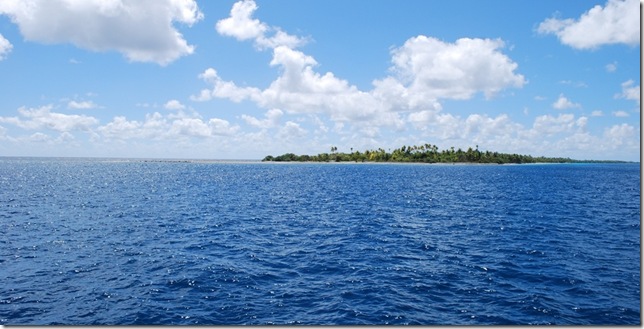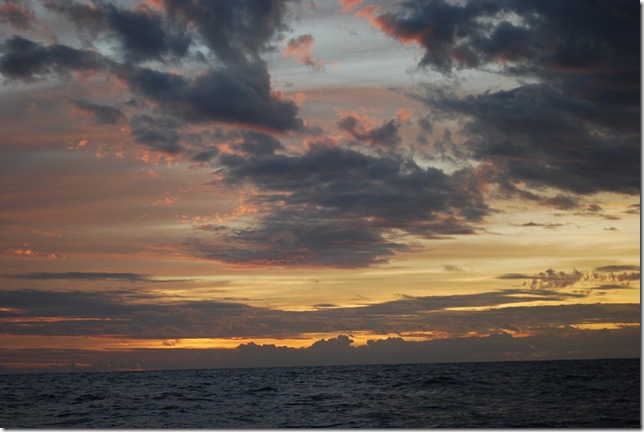Lat: 17 17.277′ S
Lon: 149 06.195′ W
Antoine had warned us that the "bombies" (Australian for coral heads) were bad where we had anchored in Fakarava and that we shouldn’t be surprised if we had trouble getting our anchor and chain up, as it may be wrapped around or stuck underneath a coral head. I’ve seen a windlass get pulled right out of a wooden deck by a captain who had his anchor chain wrapped around a coral head and tried to use the force of the swell to break it loose (thinking is was just stuck in the mud). When push comes to shove between a coral head the size of a van, ocean swell, and some part of a boat, the boat generally doesn’t fare well. Our chain was indeed stuck on a coral head, but the wind had only shifted slightly to the north while we had been anchored, so we let some more chain out, motored to the north to try to undo the effect of swinging south, and as they say here, "Voila!" In the process of anchoring I also discovered why our windlass has been so weak — the clutch needed to be tighter. There’s a manual clutch that you turn like a screw to engage or disengage the windlass motor from the gypsy (turning wheel the chain runs through). By using a wrench to tighten it instead of my hand, it was able to pull much harder without slipping, and I didn’t have to pull any of the chain or anchor up by hand at all!
Here I have to make a short digression to share a funny windlass story that Antoine told me. He had called us on the radio one night but couldn’t hear our response (cheap West Marine Radio), so I dinghied over to see what was up. He just wanted to know how our passage to Fakarava had been, but I stayed and chatted for a while. He mentioned that he was having trouble with his windlass and needed a part, but the windlass and spares were no longer in production. Since our boats were both designed and built in France within a year of each other by like-minded architects, I asked him was model of windlass he had. It turns out that it was the same windlass that was previously installed on our boat but was replaced by the previous owner (and probably just had a wiring problem). It was still in a locker when we bought it, so I’d sold it to a second-hand sailing store in St. Augustine, FL. I would be surprised if they’ve sold it, so maybe he’ll be able to contact them and buy the part he needs. (He’s been trying in vain to find the part in France.) If that wasn’t coincidence enough, he told me the story of replacing a certain part on the same windlass several years ago. After four or five years, the part had gone bad again, but now the windlass was out of production. He was trying to get by for a while and thinking about what to do when he was walking on an atoll in the Tuamotus and saw the very part he needed lying around! It was being used by a guy who sold diesel to prop up some piece of equipment. Antoine explained to the man that it was anything but scrap metal to him at the moment, and the guy told him to take it. After inspecting it more closely, he realized that it was the old part from his own windlass that he had left on the atoll years before when he got the replacement part. Although it wasn’t in perfect condition, it was now better than the "new" part, and he’s still using it in his windlass today.
Before leaving, I tried a new showering method. We’ve had several people tell us that you can enjoy a great "shower" by just jumping in the ocean naked, then toweling or rinsing off. As this seems to be the method practiced by the Swiss boat anchored in front of us, and the anchorage only had a few very salty residents, I gave it a shot. It’s definitely my favorite method so far. It’s very refreshing, and shampooing your hair with both hands while you’re treading water makes for pretty good exercise. The downside is that Irish Spring doesn’t really lather well in salt water.
We had great wind from the NE when we pulled the anchor up, so we were able to sail from the anchorage, through the pass, and then on a heading for Tahiti. Even though the north pass in Fakarava is the widest in the Tuamotus (1.5 km), the current was still strong enough that we almost had to turn on the engines to avoid being swept onto the west side of the pass. The tide was coming in, and our speed was slowed so much by the current that our leeway (wind in the sails pushing the boat sideways) and the swell was slowly pushing us from the east side of the pass to the west.
 Sailing through widest pass in the Tuamotus
Sailing through widest pass in the Tuamotus
The passage itself has been pretty uneventful. We ended up motoring the first night because the winds were too light to keep the sails set. We’re almost 2 knots faster under power after cleaning the bottom and props, so that does make the hours of work seem more worthwhile. In the morning, we set the green spinnaker, and it’s been up ever since. We’ve had a lot of hours with an average speed between 2 and 3 knots, but the wind picked up this morning and we’re doing a very easy 6+ knots and are only 25 nm from Point Venus, where Captain Cook observed the transit of Venus, the official purpose of of one of his circumnavigations (simultaneous measurements of the eclipse were intended to allow a calculation of the circumference of the earth).
We have had some cool fauna sightings. Friday night, when I went out to make a 15-minute check, I saw a bunch of glowing blobs in the water and called Lauren out on deck. We were motoring through large schools of glowing jellyfish that were between volleyball and soccer ball size. We motored through several of the schools over the next 15 minutes, which was a really cool sight. The water is so clear out there that it’s hard to tell how far down they were, but they seemed to be within 1-6 feet of the surface.
As I was near the stern preparing to set the spinnaker just before dawn Saturday, I heard the unmistakable sound of breaching. I turned around and saw a large dolphin or small whale, about 12-15 feet long, break the surface to exhale a couple of times. It was only about 15-20 feet from the stern, but in the pre-dawn twilight, I couldn’t make out enough color or detail to tell what it was.
Yesterday morning, one of the large flocks of fishing birds came close to the boat. We see them fairly frequently, but this time, there were large fish, about 2 feet long, jumping out of the water below them. Apparently the large school of fish was being hunted from below and above at the same time.
Yesterday the temperature in the salon reached a record 89 degrees, which was a little warm, although when it got down to 80 degrees in the evening with a light breeze, I was cold enough that I had to put on a T-shirt. We were talking today about how the passage to New Zealand is going to be such a climate shock for us. I’m sure we’ll be searching for pants and sweaters when the temperature drops below 75.


